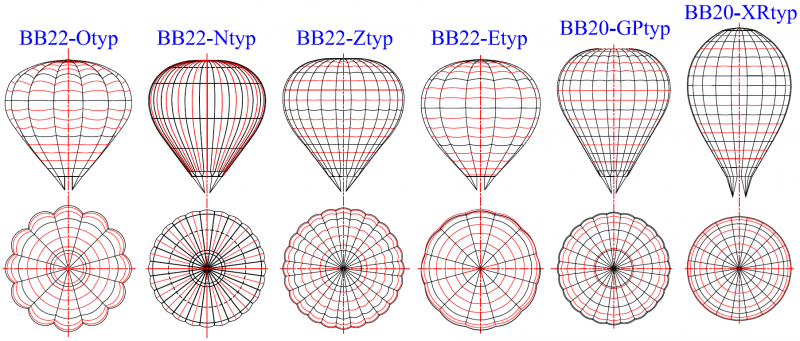The envelope is the most important component of the balloon. The envelope, which is given a serial number by the factory when it is built, also carries a unique national registration mark. National aviation authorities consider the envelope to be the aircraft, whilst the basket, burners and other equipment are only component parts.
Natural Shape
Each envelope series has its own characteristic shape designed for a specific purpose. However, they all come from one basic shape - the Natural Shape. In simple terms the Natural Shape is one in which the fabric only stretches horizontally and the load of the basket is carried by the load tapes.
There are a number of variables within the equations that the design engineer’s use and these result in the different balloon manufacturers developing envelopes that, although similar, are not identical.

Critical Envelope Parts
As we have mentioned before, the weight of the basket is carried by the envelope’s vertical load tapes. The load tapes form the major part of the “primary load path” which runs all the way down each vertical load line from the crown ring, along the load tapes and then through the attachment points to the flying cables and karabiners to the balloon’s burner frame. All these components are critical to the safety of the balloon. When the balloon is being used or inspected it is very important to pay close attention to these parts. If damage, beyond the limits stated in the Maintenance Manual, is found then the balloon is unserviceable until the damage has been repaired.
Vertical Load Tapes
Load tapes are made from Polyester because it degrades slowly and has a high UV endurance. Because the load tapes are thick they degrade more slowly than the envelope fabric so there is no need to measure their strength during the balloon‘s operational life. The attachment points at either end of the load tapes are sewn with a special double stitching that ensures that they will not fail.
Horizontal Tapes
The horizontal load tapes take some of the horizontal stress from the fabric but they are much less critical than the vertical tapes. However they do prevent the propogation of a rip if a fabric panel is damaged.
Horizontal load tapes are not used in diagonally cut envelopes as any damage to the fabric of the envelope would be stopped as soon as it reached a vertical load tape.
Balloon Fabric
Airtight balloon fabric forms the bag of the envelope within which the hot air is contained.
The normal fabric used in envelopes is Kubicek Polyester because it is long lasting and bright, however, Kubicek can, if requested, build envelopes from Nylon or Hyperlast.
Envelope Inside Temperature Measurement
All envelopes have, for reasons of flight safely and in order to comply with the current legislation, an indicator showing when the envelope’s maximum operating temperature has been reached. Every envelope is fitted with a simple Melting Link and may also be fitted with an electronic temperature sender (e.g. Flytec 3040).










 Kamila, assistant
Kamila, assistant Ivo, salesman
Ivo, salesman Martin, salesman
Martin, salesman Milan, salesman
Milan, salesman David, sales manager
David, sales manager Petr
Petr Ondřej, service & after-sales care
Ondřej, service & after-sales care Radim, chief-designer
Radim, chief-designer Radim, executive director
Radim, executive director